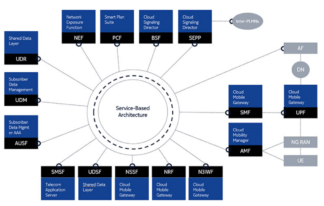5G systems will offer a large variety of 5G services with different requirements. 5G networks will need to support high-availability, low-latency services for critical communications, provide extensive coverage and super-high speeds for eMBB communications and offer low-cost, low-energy services for massive MTC communications. Telecom Operators will, therefore, have to develop a new end-to-end 5G network architecture to address these challenges.
The main aim of the 5G core is to deliver an automated and service-oriented solution with increased efficiency, agility and scalability to be able to integrate different technologies, provide diverse services and support existing and new business areas.
5G system architecture has to offer data connectivity and advanced services, enabling deployments to use techniques such as Network Functions Virtualization (NFV) and Software-Defined Networks (SDN).
5G system basic structure
A 5G system typically consists of a 5G Access Network (AN), a 5G Core Network (CN) and User Equipment (UEs). 5G Access Network is an access network that consists of an NG-RAN and/or non-3GPP AN connecting to a 5G Core Network as specified in TS 23.501.
NG-RAN is actually a radio access network for 5G services that comprises of gNBs (5G NR base stations) and NG-eNBs (LTE eNBs supporting 5G CN).
In 5G CN the User Plane (UP) functions are separated from the Control Plane (CP) ones. There is also concurrent access to local and centralized services, while the functional design is modular via network slicing. With enhanced support of a distributed cloud, a UE can simultaneously access both local and centralized networks within a single connection, and the user can connect to multiple slices simultaneously.
5G Key Differences from LTE/EPC
The main difference between 5G CN and LTE/EPC is the virtualization of functions. Network Slicing is introduced to Core and RAN to create distinct instances and different network functions.
Service Based Architecture is used to enable a cloud-native core implementation and allow for fast service creation. 5G CN supports enhanced QoS functionalities where per-flow QoS/QoE is possible, with each flow individually recognized even within the same Access Point Name (APN).
5G CN supports a Common Access Network architecture for various RAN, Wi-Fi, Fixed, Satellite, and other services, where devices without SIM cards may also be supported to enable IoT connectivity. This new 5G core will provide convergent user plane functions with higher bandwidth, lower latency, and simpler management for the support of non-mobile devices or services.
Migration from LTE EPC to 5G CN
5G NR is based on Non-Standalone and Standalone architecture. The non-standalone architecture will use the existing LTE infrastructure to support the first 5G deployments. LTE RAN is currently connected to the EPC. Since the EPC was designed for LTE applications, it is limited to Non-Standalone mode. 5G services running in a Non-Standalone mode will have to connect to an enhanced, 5G-enabled EPC. In order to provide a 5G Standalone network, 5G NR will have to be connected to a separate 5G Core Network with NFV/SDN distributed cloud and network slicing.
For 5G network migration it is essential to move from integrated nodes with dedicated hardware, static capacity and element management to virtualized solutions with commercial off-the-shelf (COTS) server hardware and virtual network functions (VNF) management. 5G core network will have to be developed on a software-defined cloud infrastructure with network slice orchestration for optimized applications and 5G network services.
3GPP Release 16 Study Items on 5G Core
3GPP is working towards the creation of a 5G ecosystem that will be able to support the advanced services and use cases of 5G networks. 3GPP Release 16 will expand the works of Rel.15 that set the standards for 5G NR. Regarding 5G CN, the focus is currently on the following areas:
Architecture enhancements for 3GPP support of advanced V2X services
Wireless and Wireline Convergence for the 5G system architecture
Access Traffic Steering, Switch and Splitting support in the 5G system architecture
Data Driven Network Automation
Cellular IoT support and evolution for the 5G System
Enhancing Topology of SMF and UPF in 5G Networks
Enhancement to Service-Based Architecture for Location Services
Enhanced IMS to 5GC Integration
Improvements to the Service-Based 5G System Architecture
Network Slicing Phase-2
Enhancement of URLLC support in 5G
Application Awareness Interworking between LTE and NR
Single radio voice continuity from 5GS to 3G
Encrypted traffic data detection and verification
System enhancements for Provision of Access to Restricted Local Operator Services by Unauthenticated UEs
Enhanced 5G services need an advanced 5G core that will be able to provide flexibility and support dynamic allocation of services on demand. Creating a standalone 5G network is definitely a great challenge and may take several years to achieve. However, the right standardization steps are underway to offer a cautious migration from the existing LTE EPC to the 5G Core Networks of the future.













